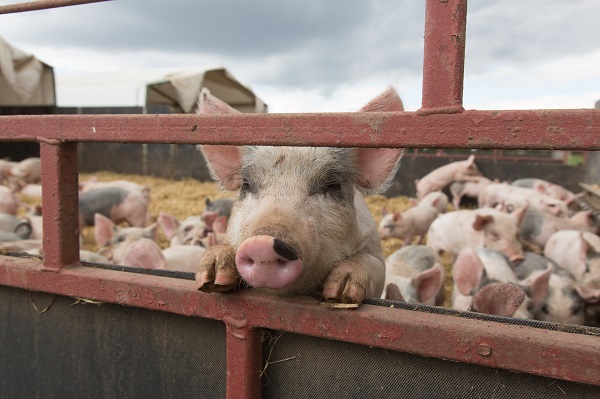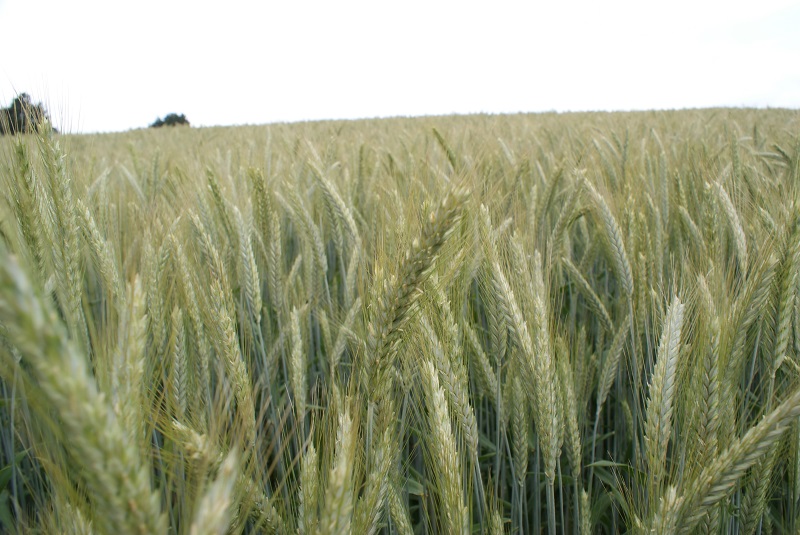Recent research has shown there’s a range of cereal varieties that outyields most wheats and performs better in feed rations, but outdated views prevent the benefits from being taken up on farm. CPM reports.
In our trials, it outperformed wheat across all soil types, including silts and clay loams.
By Tom Allen-Stevens
What would be your dream replacement for your current second wheat? Start with a yield that’s 8% higher, and 3% higher than your first wheat. How about one that’s largely resistant to septoria, much less affected by take-all, and generally needs about 40kg/ha less N?
This super cereal would establish fast and be highly competitive against blackgrass, rivalling and probably beating hybrid barley, and have a reputation to shrug off rabbits, too. The seed cost would be comparable or lower than your

Harley Stoddart believes it’s a chicken-and-egg situation – there are benefits for growers, but these are held back by a lack of market demand.
current wheat, with as wide a drilling window and you’d be able to farm-save the seed. The grain would blend seamlessly with feed wheats and have a better nutritional value, making it attractive for pig and poultry diets.
If you were then to discover these stunning credentials had actually been distilled into a range of modern, high-performing and stiff-strawed varieties and that they’re widely available, you’d probably be keen to know what they were. We’re talking about triticale. Now you’re disappointed, right?
Low input requirement
Triticale is a cross between wheat and rye, produced to combine the grain qualities of wheat with the low input requirements and hardiness of rye. As such, it’s had a reputation in the UK as a low-yielding crop, best suited to poor or marginal soils.
But this may be an ill-conceived perception – recent research, funded mainly by Innovate UK and AHDB Cereals and Oilseeds, has revealed a hitherto unrecognised side of this cereal that has the potential to position it alongside wheat as a major player in the market.
“Modern triticale varieties are not what they were,” notes Harley Stoddart of AHDB Cereals and Oilseeds. “That’s why it was worth spending time and resources examining their potential.”

Triticale’s digestible and net energy values are very similar to wheat, and a current market price discount positions it very favourably as an ingredient in pig rations.
The main project has been a 40-month industry-funded tranche of research that set out to investigate its potential as a feedstock for bioethanol. Running alongside that has been an AHDB-funded project, carried out by ADAS, that has explored the potential and on-farm performance of the crop in more detail. The findings have been distilled into a new, grower-friendly guide that was published in March this year (see panel on pxx).
“It’s a chicken-and-egg situation – we now know there are benefits for growers, and what these are, but what’s holding the crop back is a lack of market demand,” explains Harley Stoddart.
To a certain extent, this was addressed in the research, and an additional project, funded by AHDB Pork, has also assessed the crop’s value in pig rations. Tests have shown triticale is suitable as a bioethanol feedstock, albeit producing a marginally lower ethanol yield per tonne than wheat.
This is countered by a higher yield per ha, and lower greenhouse gas emissions give triticale a favourable carbon footprint, since it requires less N per tonne produced on farm. But a slightly higher viscosity from the bioethanol means triticale would only ever be blended as part of the potential one million tonne UK requirement for this market.
“The direction of travel is towards a feedstock with a better carbon footprint than wheat, and there’s no doubt triticale performs on that score,” reports Harley Stoddart.
“From Jan 2017, there’ll be changes that will tighten the requirement for biofuels, but most UK wheat falls within those parameters. What’s more, the need to blend triticale as a feedstock means the carbon footprint advantage of using the crop will be diluted. So despite the plus points for triticale, it’s just easier for biofuel plants to source feed wheat at the moment.”
The bigger potential market for the crop is as animal feed, he concludes. “The project has established that the DDGS (dried distillers grains and solubles), created as a by-product of bioethanol production, are suitable for animal feed.”
Triticale grain itself has a reputation for being well suited for pig feed due to the high concentration of the amino acid lysine which pigs require. This was confirmed in the project, and the AHDB Pork-funded work has now updated reference data on its value as an ingredient in rations.
Its digestible and net energy values are very similar to wheat, and a current market price discount positions triticale very favourably as an ingredient in pig rations. But again, in practice nutritionists would probably restrict its inclusion to no more than 25% in rations because there’s a perception that high beta-glucans in the triticale could cause digestive upsets.
See the benefits
“Feed compounders aren’t resistant to triticale – they can see the benefits and we’re currently trying to establish what will incentivise them to remove the pegged-down price or to include more in rations,” reports Harley Stoddart.
“We’re finding getting answers is not straightforward, and much of it comes down to logistics, again. If they were confident there was plenty of availability and continuity of supply, it’s likely that would stimulate demand.”
Just how much triticale currently reaches the UK grain market is unknown – Defra stats show there are 36,000ha of minor cereals grown in the UK, comprising rye, triticale and mixed corn, producing 247,000t. That compares with wheat’s 1.8M hectares producing 16M tonnes. There’s anecdotal evidence to suggest a large proportion of triticale grown is used in on-farm feeding rations, or blended in and sold as feed wheat, as the two grains are virtually indistinguishable.
But for Dr Daniel Kindred at ADAS, who led the research, the current treatment of the crop, both on farm and by the market, grossly underplays its potential. “I find it frustrating that this is a crop with a real opportunity – it should be a contender in crop rotations and should be of value to end users. But on both scores, it’s held back purely because of ill-founded perceptions.”
Among the perceptions he feels have now been “scotched”, following the research project, are that triticale is a crop that’s low-yielding and that it it’s best restricted to poor or marginal sites.
“In our trials, it yielded higher than wheat on 20 out of 26 sites – an average advantage of 8%. It outperformed wheat across all soil types, including silts and clay loams. The best result was 37% higher than wheat on a sandy clay loam in N Yorks.”
It’s as a second cereal where triticale really outperforms wheat, and take-all index measurements show it’s less affected by the disease, he says. “When it comes to nitrogen, we were surprised to find that the measured N optima for triticale are actually the same as wheat. Recommendations have been to apply 40kgN/ha less than you would for wheat – that would give comparable yields. But it’s a crop you can push, although lodging risk is relatively untested. So I’d be cautious about applying more N than you would for a moderate-yielding feed wheat, and do this in conjunction with a robust PGR programme.”
Detailed work has been carried out on how triticale forms its yield and utilises N, however. “There’s a much shorter growth phase up to GS31, and less time before flowering. But grain fill is longer – triticale has more grain sites to fill. It also produces much more biomass than wheat.”
More efficient than wheat
Green area index (GAI) and light interception measurements show a similar picture, indicating the crop picks up its higher yield by being more efficient than wheat at utilising N.
“Triticale’s agronomy is very similar to wheat,” continues Daniel Kindred. “There are varieties susceptible to yellow rust and these should be handled just like susceptible wheat varieties. One notable difference is that the crop is definitely more vigorous early on, with greater weed suppression. It’s competitive against blackgrass and potentially better than hybrid barley.”
Triticale’s weed competition hasn’t been researched in replicated trials, but grower feedback echoes this finding, says Dr Sarah Clarke of ADAS. “As part of the project, a number of growers conducted tramline trials, comparing wheat with triticale. We certainly had good feedback about its blackgrass suppression. It smothers the weed and holds it back throughout the season. Near harvest, the heads are there, but you have to look into the crop to find them.”
All feedback confirmed that triticale performed well, particularly on more marginal sites. “But where growers had put it on stronger land, it did perform better than their wheat. They found the difference in growth was impressive, and there was quite a bit of surprise at the results. We asked specifically about rust, and it wasn’t seen as an issue.
“The only drawback was what to do with the crop once harvested – there was real difficulty in selling it,” she reports.
Daniel Kindred believes there’s plenty of scope for further research to develop the agronomy of triticale, explore its weed competitiveness and address market concerns. But Harley Stoddart thinks it is time to reflect on what is already known before embarking on a new phase of research.
“Triticale’s potential has been unlocked by this research. The door is open and now it’s up to the industry to work together to hatch a solution to the ‘chicken-and-egg’ conundrum. But one thing is clear: only growers can generate the consistent tonnage required by feed compounders. This critical mass is relatively small, when compared to the whole of the arable production area in the UK, and we hope that the latest findings will help set triticale on its rightful path to achieving that goal,” he says.
How the margins stack up
| 2nd Wheat | Triticale | |
| Grain yield (t/ha) | 7.5 | 8.1 |
| Grain price (£) | 130 | 120 |
| Grain output (£/ha) | 975 | 972 |
| Straw output (£/ha) | 140 | 151 |
| Variable costs (£/ha) | ||
| Seed and treatment | 70 | 70 |
| N fertiliser | 174 | 174 |
| Other fertilisers | 80 | 86 |
| Fungicides | 100 | 70 |
| Insecticides/herbicides | 70 | 70 |
| PGRs | 15 | 20 |
| Total variable costs (£/ha) | 509 | 490 |
| Gross margin (£/ha) | 606 | 633 |
| Triticale advantage (£/ha) | 27 |
Source: AHDB Cereals and Oilseeds; wheat yield is UK average; triticale yield based on average advantage seen in trials (8%).
Step change with leading varieties
There’s a Descriptive List for triticale that provides some data on latest varieties, notes Simon Oxley, AHDB Cereals and Oilseeds Recommended List manager. “The DL is based on independent trials, but there’s no selection, as there is for other crops,” he notes.
“Also, the information is based on grain markets only, so varieties best suited to wholecrop or energy use won’t be listed.”
That said, KWS Fido, marketed by Senova, draws the eye, he points out. “A yield of 109 is significantly ahead of controls, and there’s a good specific weight and protein to back this up.
“But straw length is a little high, so if this is a concern, newcomer Cyrkon from Dalton Seeds may be attractive. Again this has good protein and a reasonable specific weight.”
While this year’s newcomers are “nothing special” on yield, the varieties described have come on significantly in recent years, Simon Oxley points out.
“We’re seeing very good yield scores with stiffer, shorter straw, while they’re keeping their quality and not pushing harvest date later – these are all signs of a step change in the calibre of varieties coming forward.”
Added value for pig producer
The perception that triticale is a second-rate crop is one that Martin Barker, managing director of Midland Pig Producers, often comes up against. “We have struggled to get our farm manager to accept it as a feed,” he says. “Nutritionally, I’d put it in front of wheat in terms of its value, but it’s always considered second best.”
Based in Alrewas, Staffs, the Leavesley Group farms 1600ha, a considerable proportion of which produces the feed ingredients home-mill and mixed for MPP’s 2000-strong sow herd that produces 60,000 pigs/yr. “We grow what we consume and consume what we grow,” notes Martin Barker.
The basic crop rotation is two wheats, followed by barley and then beans. But for the past 25 years, triticale has taken the place of much of the second wheat. “It makes sense for the lysine value,” he explains.
“You need a lysine content in the ration as it’s beneficial for lactating sows and it helps pigs digest other nutrients and turn them into energy. It costs me £1200/t as a raw ingredient, but triticale provides extra lysine for free.”
Included at up to 25% in the ration, he hasn’t noticed any downside from including triticale. “When we first started growing the crop, it grew to over six feet tall and took some combining. But modern varieties are very easy to manage, and perform easily as well as a second wheat. One thing you do notice is the vigorous growth – it comes up a dark green and looks like Rambo in the early part of the season.”
Last year, the crop was given a particular challenge. “We grew 40ha next to the River Trent on alluvial soil. The field’s bound on one side by a dual carriageway and, to add insult to injury, there’s a railway line, too, making it a haven for rabbits. The land flooded not long after it was drilled at the end of Oct.”
Following wheat, the land received dried pig muck spring-tined into the surface before the variety Tribeca was drilled with a 4m Simba Horsch Sprinter. “It didn’t get a chance for a herbicide and stayed completely flooded until spring. When the water receded, the field was brown, but we couldn’t get on until the end of April, by which time the crop had greened up, so we gave it a chance.”
It received just one fungicide and 150kgN/ha, but needed no PGR. “The recovery has been staggering and the crop looks as though it will perform almost on a par with others,” reports Martin Barker. His average yield is 9t/ha.
“One thing you notice about triticale is that it doesn’t seem to need a period of vernalisation. A Nov-planted crop seems to work well, but we’ve drilled well into spring and the crop has still performed.
“The varieties these days are much better and more consistent. It won’t outyield a first wheat of Skyfall, but as a second cereal, there’s little that’ll match triticale,” he notes.
Research round-up
AHDB Project Report 556, Modern triticale crops for increased yields, reduced inputs, increased profitability and reduced greenhouse gas emissions from UK cereal production, is available to download at cereals.ahdb.org.uk. It is the final report of two projects, detailed below:
AHDB project RD-2010-3699, Modern triticale crops for increased yields, reduced inputs, increased profitability and reduced greenhouse gas emissions from UK cereal production, ran from March 2012 to June 2015. Its aim was to understand how triticale outperforms wheat to help target situations when it should be grown. Led by ADAS, with Agrovista as an industry partner, its total cost was £70,000, funded by AHDB Cereals and Oilseeds.
Innovate UK project 101093, Improving the sustainability and quality of Dried Distillers Grains with Solubles (DDGS), the high-protein animal feed co-product from bioethanol production, by using triticale as a biofuel feedstock, ran from Jan 2012 to Sept 2015. Its aims were to demonstrate cost and environmental benefits of triticale over wheat, evaluate grain, alcohol and DDGS quality in the lab, optimise protein output and demonstrate market utility by processing triticale in a commercial plant. Led by Agrovista, ADAS, Ensus, GrowHow, RAGT, Saaten-Union and Senova were industry partners. Its total cost was £486,732 with Innovate UK funding £243,366.
Understanding triticale was published by AHDB Cereals and Oilseeds in March 2016 and summarises the output of related research. cereals.ahdb.org.uk
AHDB project, Understanding the value of triticale in grower and finisher pig rations, ran from May to July 2015. Its aim was to demonstrate the economical and nutritional value of triticale in grower and finisher pig rations compared with wheat and barley. Led by ADAS, its total cost was £3186, funded by AHDB Pork.




